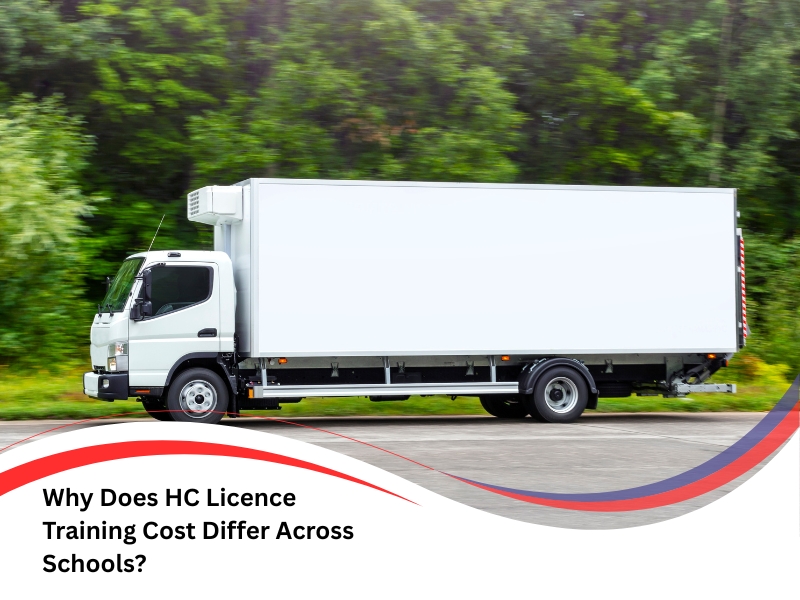When comparing options for your heavy vehicle licence, the HC licence training cost can vary wildly from one provider to the next. It’s not unusual to see price gaps of hundreds of dollars between schools, even when they’re offering seemingly similar services. That leaves you wondering what you’re paying for — and whether higher costs mean better training or just clever marketing. This article examines the key factors that influence the cost of HC licence training, including course structure, duration, financing strategies, and external factors such as seasonality and regulations. You’ll also discover how the student experience and inclusions differ across programs, helping you navigate your choices more clearly.
What does the HC licence training usually include?
When you enrol in a course, you’re paying for more than just driving lessons. Most HC licence training programs are packaged with multiple inclusions, and those can vary significantly between schools. Here’s what commonly gets bundled in:
- Vehicle hire: Use of a heavy combination truck for practice and test day, often a significant cost driver.
- Qualified instruction: Time with an accredited instructor or assessor, sometimes one-on-one.
- Course materials: Manuals, safety booklets, and logbooks are required for theory components.
- Fuel and maintenance: Operating a training truck isn’t cheap — fuel costs and mechanical upkeep are baked into the price.
- Licensing test fees: Some schools include RMS testing fees, while others pass them on separately.
- Practice hours: The number of driving hours included can differ; some provide more comprehensive on-road exposure.
It’s essential to clarify which of these are included upfront. Some lower-cost providers might skip a few items to advertise a more appealing price. Consider finding reliable information on the heavy combination licence training cost and inclusions to understand better what’s standard and what’s extra.
How long does HC licence training take, and what affects the cost?
The timeline for completing your training can impact how much you pay and how quickly you can obtain your professional licence. Typical course durations include:
- Accelerated 1-day courses: Designed for experienced drivers with existing HR licences who meet specific competency standards.
- Standard 2–3 day courses: The most common option for those with intermediate driving experience.
- Extended 4–5 day formats: Suited for beginners or those seeking additional practical hours.
Here’s a quick comparison of the standard course.
Course Type | Duration | Ideal For | Avg Cost Range (AUD) |
Accelerated (1-day) | 6–8 hours | Experienced drivers | $750 – $1,000 |
Standard (2–3 days) | 14–18 hours | Intermediate experience | $950 – $1,400 |
Extended (4–5 days) | 20–25 hours | New drivers or skill refreshers | $1,200 – $1,800 |
Weekend format | 2 weekends | Busy professionals | $1,300 – $1,900 |
As you can see, course length directly impacts cost. Still, more hours don’t always mean better value — the structure and support offered matter just as much.
How can you finance your HC licence training cost-effectively?
Affording a licence upgrade doesn’t have to empty your wallet in one hit. Several funding options can make it easier to spread or reduce the cost. Here are ways to keep costs manageable:
- Payment plans: Many schools offer weekly or fortnightly instalments to avoid lump-sum stress.
- Centrelink support: If you’re receiving benefits, you may qualify for subsidised training programs.
- Government traineeships: Some states fund partial or full training for eligible employment seekers.
- ATO deductions: If your new licence relates to your current role, course fees may be tax-deductible.
Flexible payment strategies also help you avoid delaying training due to cost. You can explore the benefits of holding an HC truck licence if you’re looking to justify the expense long-term. Whether you’re upgrading your skills or changing careers, it’s smart to weigh up your funding choices early.
Do seasonal discounts affect HC licence course pricing?
Yes — just like airfare or hotel bookings, HC licence courses often run special rates at certain times of the year. Keep an eye out for:
- Off-peak discounts: Slower months, such as winter or post-holiday periods, may be accompanied by lower fees.
- Early bird specials: Booking your spot in advance can sometimes unlock a discount.
- Group enrolment offers: Training with a mate or two? Some providers offer reduced rates for group bookings.
- Rebate incentives: Occasionally, schools offer partial refunds on successful licence completion.
While these promos can be appealing, make sure the core offering hasn’t been stripped back. Discounted training with reduced hours or less instructor access might not save you in the long run if it results in retesting or failed attempts. Still, seasonal deals are worth considering if you’re flexible with timing and want to save a few dollars on your spend.
How does the student experience influence HC licence training prices?

Not all training experiences are equal. Premium pricing often reflects a school’s investment in student support, facilities, and services. Here’s what might increase the cost but improve your training quality:
- Modern vehicles: Up-to-date fleets offer more realistic driving experiences and better safety.
- Instructor expertise: Schools with more experienced trainers might charge more but provide stronger pass rates.
- Personalised feedback: Ongoing coaching, tailored lesson plans, and post-training advice improve learning outcomes.
- Convenience factors, such as free parking, central locations, and flexible session times, all add to operational costs.
On the other hand, a no-frills training centre might save you money upfront, but that often comes with a less supportive, more challenging experience. If you hit a bump in the road, such as failing a test, you could end up paying for repeat attempts. Understanding how to appeal a rejected HC licence application is a valuable safeguard, especially if your training doesn’t fully prepare you for the assessment.
How do government rules impact HC licence training costs?
Costs don’t just come from what schools offer — they’re also shaped by what governments require. Here are some regulatory influences on HC licence pricing:
- Mandatory curriculum standards: Schools must comply with RMS-approved training frameworks.
- Instructor certification: Trainers need up-to-date qualifications and re-accreditation, which come at a cost.
- Test centre availability: In regions with limited testing spots, scheduling fees can spike.
- Vehicle compliance checks: Regular inspections and insurance are legally required for training fleets.
- Training facility approvals: Schools operating from accredited venues face leasing and licensing overheads.
In short, regulation adds legitimacy — and sometimes cost — to your training. But those protections are in place to ensure you’re road-ready, not just test-ready. For more background on the national framework, you can refer to the Australian driver licensing standards for heavy vehicles to understand the minimum expectations across states.
Final thoughts
While it’s tempting to focus only on price, the HC licence training cost is just one piece of a much larger puzzle. The real value lies in what you receive for that fee: vehicle access, support, teaching quality, and a realistic shot at passing your test the first time around. There’s no shame in shopping around, but do it with your eyes open. Ask questions, request inclusions in writing, and weigh long-term outcomes against short-term savings. If you’re curious about what to expect and how to get ready for your training, take a moment to see how Core Truck Driving School can help you address your concerns.


